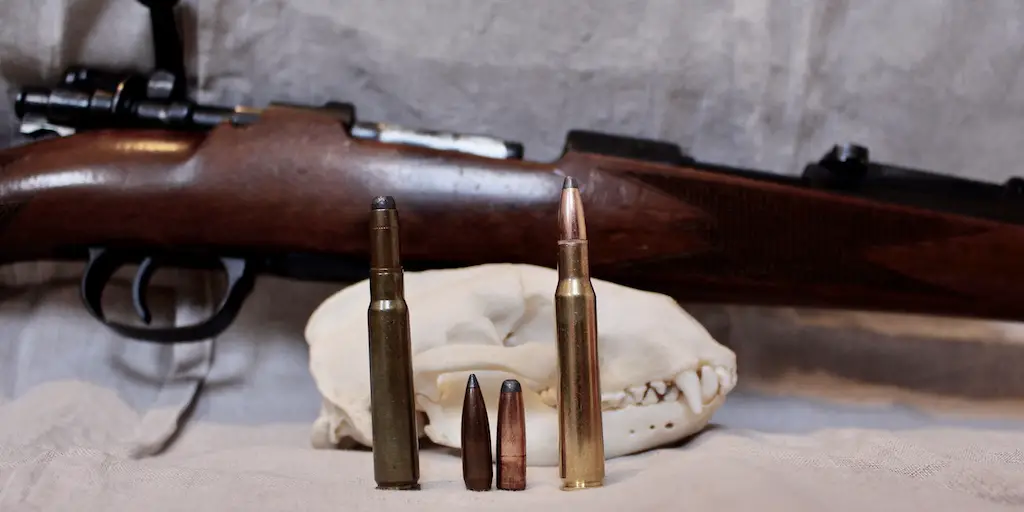By Lukas Schulte
Trying to decide between the classic 8mm Mauser vs 30-06 Springfield cartridges? Here’s what you need to know about them.
You slowly crawl forward with your eyes locked in on the grey rump barely visible between the limbs and leaves. After what seems like a lifetime of crawling, you reach a spot where you can take aim and wait for a clear shot.
The deer takes one more step forward, his shoulder appears from behind a tree, and the shot breaks. He attempts to take a few weak steps, but rapidly collapses within view.
Chalk up another deer to your trusty hunting rifle!
If you live on the western side of the Atlantic Ocean, that rifle could very well be chambered in .30-06 Springfield. That war horse is proven, reliable, and almost boring in its efficiency.
On the other hand, hunters on the other side of the Atlantic often use a different cartridge: the 8mm Mauser, more often called the 8x57IS. Though the 30-06 cartridge is extremely popular in Europe as well, the 8mm Mauser remains a ubiquitous hunting cartridge.
Despite their different names, both the 8mm Mauser and 30-06 Springfield are both useful cartridges that share quite a bit of overlap in capability. That said, each also has a few advantages over the other.
In this article, I investigate the 8mm Mauser vs 30-06 debate in detail and provide some insight into which new rifle cartridge is ideally suited for various hunting situations so you can make an informed decision on which one will work best for your individual needs.
History Of The 8mm Mauser & 30-06 Springfield
The 8x57mm round first saw the light of day in 1888 and was originally denoted as the Patrone 88. Also known as the M88, the cartridge debuted with the new Mauser Model 88 rifle, which was a predecessor to the famed Model 98 rifle.
The military leadership of the German Empire began the search for a new rifle cartridge in 1887 to compete with the French 8x50R Lebel cartridge (often called 8mm Lebel). The Germans feared their arch-rival would gain a significant advantage on the field of battle using that new cartridge, which was among the first rifle cartridges ever designed to use smokeless powder of the day.
Tensions remained high between the Germans and French after the Germans emerged victorious from the Franco-Prussian War of 1870-1871. Not only did the Germans defeat the French during that short, but vicious war, but they forced the French to pay a hefty indemedty and cede portions of the provinces of Alsace and Lorraine over to German control.
Well aware of the desire on part of the French to avenge that humiliation, the Germans did not want to give them an advantage in the small arms field and set about designing a new cartridge using smokeless powder for their troops to use as well.
That initial Patrone 88 round used about 40 grains of smokeless powder to push a .318″ caliber round nose bullet weighing 14.7g (around 227 grains) to just over 2000 fps.
The new cartridge also saw use as a civilian hunting round using the standard metric cartridge designation system of bullet diameter x case length in millimeters. Additionally, this new round carried the moniker “infantry” (Infanterie in German), which gave the 8x57I its full name.
Interestingly, the often used “Mauser” designation is very uncommon in Europe, but most likely stems from the close knit connection to the Mauser rifles.
German authorities revised the cartridge in 1905 in an effort to squeeze more performance out of 98 Mauser rifles. These revisions came in the form of two primary changes: a slightly larger bullet diameter of .323″ and the use of a lighter and more aerodynamic 153 grain (9.9g) bullet construction with a pointed nose.
This revised cartridge received a new “S” designation, (for Spitzer or Stark (German for strong) depending on the source), to clearly distinguish it from the older round.
The new 8x57IS was significantly more powerful than the older 8x57I and had roughly 37% higher muzzle velocity (878 m/s, or 2880 fps) and 28% more muzzle energy. The newer bullets gave better accuracy from the barrels of the day.
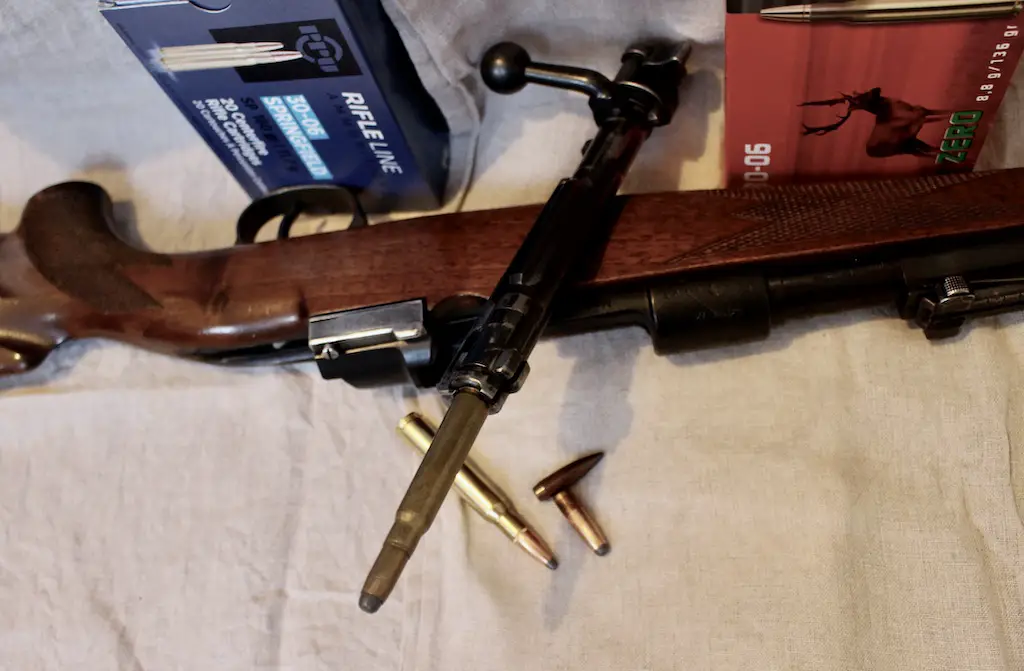
Both cartridges remained on the market for a time, but the smaller diameter I-version (Patrone 88) has almost completely disappeared in bolt rifles. So, there is a very low risk of getting confused and loading the wrong ammunition in the wrong gun (which could potentially be disastrous).
Additionally, a rimmed version of the 8x57mm was released almost simultaneously for hunters that use break action rifles like drillings. You can find both 8x57IR (infantry rimmed) and 8x57IRS (infantry rimmed spitzer) ammo on the market to this day.
No new weapons are chambered for the older and weaker round, but my father for example inherited a drilling in said round from his father. That gun is in still in use, and members of my family have taken a fair share of game with that.
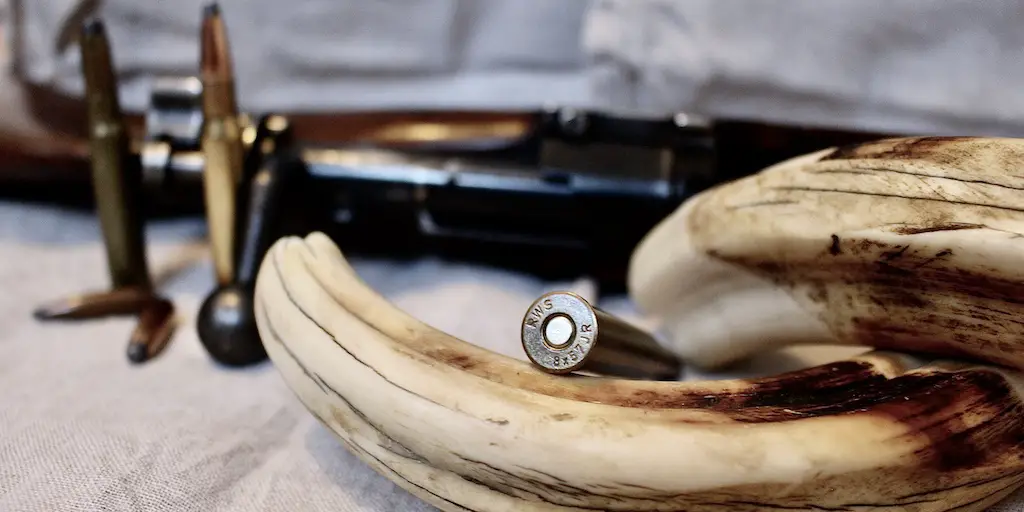
The rimmed sisters of European rimless designs usually run a bit slower, as they’re approved with 5-10% lower chamber pressure, but that won’t matter too much for most hunts.
As a side note, the 8x57mm cartridge was banned for a few years in Germany after WWI. That led to the invention of other cartridges (like the 8x60mm cartridge, that could be used in slightly altered old service guns) and was also a boon for other rounds with no military use like the 8x68mm S.
The 8mm Mauser remained popular with the hunting community in Central Europe after both World Wars in areas where sportsmen could legally use military service rounds. The 8 mm Mauser cartridge remains one of the most popular hunting cartridges in that area today due in large part to its suitability to short rifle barrels and effectiveness on any game roaming the continent.
Now let’s switch gears and look at the American 30-06 Springfield.
The US Army adopted the 30-40 Krag as its first smokeless service cartridge in the 1890‘s.
That cartridge used a .308″ 220 grain round nose bullet pushed by about 40 grains of smokeless powder. Though it was a big improvement over the older black powder .45-70 Govt, the 30-40 Krag couldn’t hang with the European service rounds of the day like the 6.5×55 Swede and 7mm Mauser.
Although the US won the Spanish American War, the bloody nose the Army received at the hands of 7mm Mauser armed Spanish troops made it obvious to American military leadership that they needed a new cartridge.
They began work on their new rifle and cartridge and the result was the rimless .30-03 Springfield, which came along a few years later. That cartridge launched the same .308″ 220gr round nosed bullets from the new M1903 rifle at about 2,300 fps (700 m/s).
While this was a considerable step up in performance compared to the 30-40 Krag, authorities still weren’t pleased with those ballistics.
So, they made some changes to the 30-03 and released a new cartridge in 1906: the .30-06 Springfield.
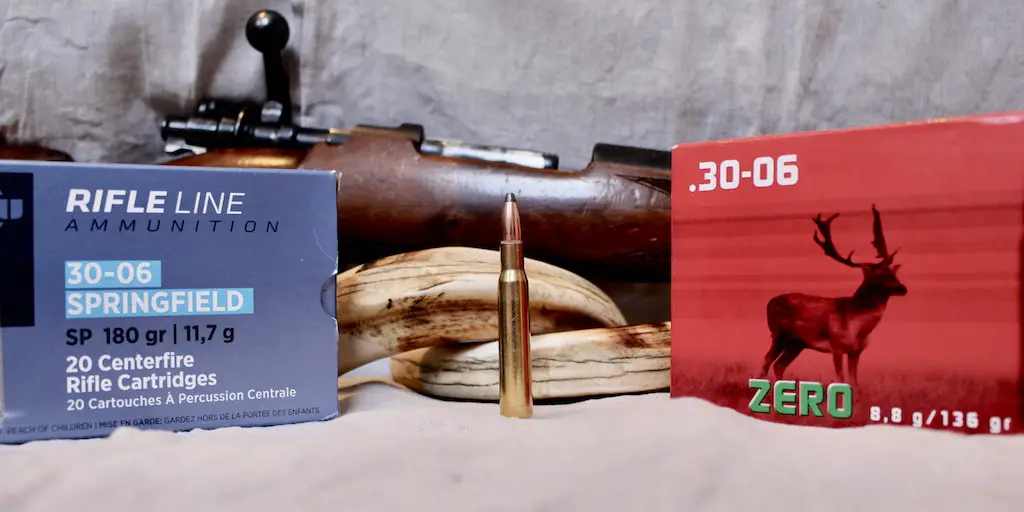
Similar to what the Germans did with the 8x57mmIS (though the Americans used the same bore diameter for the 30-03 and 30-06), the new 30-06 fired a 150 grain spitzer/pointed bullet at 2,700 fps (820m/s) for the original military loads.
This offered a tremendous step up in performance over even the 30-03.
On one hand, one could say the American 30-06 round was inferior to the German 8mm Mauser due to its lower muzzle velocity (2700 vs 2880 fps). On the other hand, the 30-06 used a bullet with a higher ballistic coefficient of .405 compared to a BC of just .330 for the 8mm Mauser.
We’ll discuss the implications of those differences later in this article.
Indeed, the 30-06 remains a standard for big game hunting cartridges that stands to this day. The American military used the cartridge as the primary infantry service round in World War I, World War II, and the Korean War as well as in smaller numbers during the Vietnam War before the US military finally completely replaced it in the late 1970s.
Additionally, the 30-06 quickly caught on with the civilian sporting community and remains one of the most popular rifle cartridges around the globe right now.
30-06 vs 8mm Mauser Cartridge Sizes
The two former military rounds show a few differences in their external dimensions.
First, the Springfield uses .308″ bullets while the Mauser uses larger diameter .323″ bullets.
The cases are also easy to distinguish. The Springfield case measures 2.494 inches in length, with a rim diameter of .473 inches. The8x57mm case is 2.244 inches long and stands on a .470 inches wide rim. Also, the .30-06 shows a little less body taper.
Both cartridges have similar shoulder angles: 17.5 degrees and 19.1 degrees for the .30-06 and the 8mm Mauser respectively. Both also feed well from box magazines.
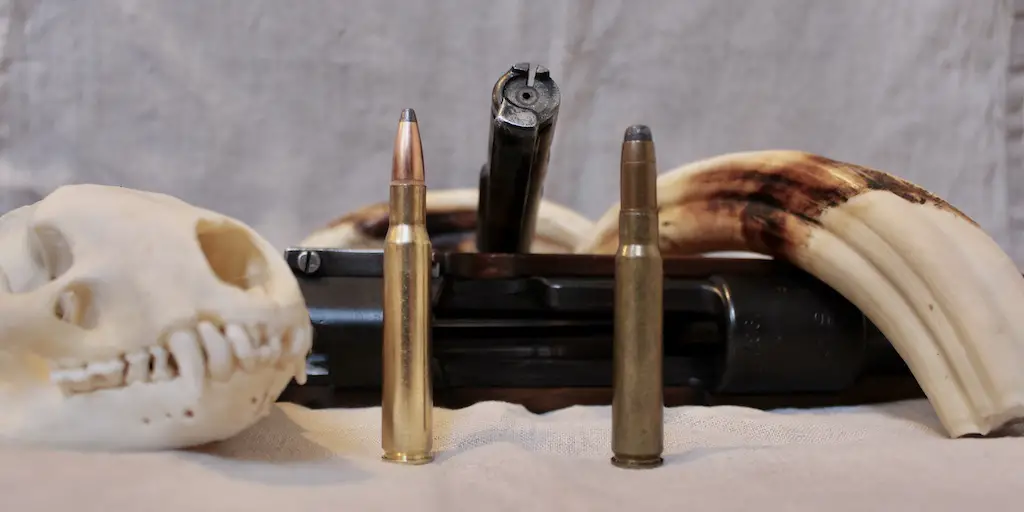
With a cartridge overall length of 3.34″ for the 30-06 and 3.228″ for the 8×57, both fit perfectly into standard length bolt actions.
All things considered, the American cartridge has a 7-8% advantage in case capacity. Combine that with higher chamber pressures (60,000 psi for the Springfield vs. 56,560 psi for the Mauser according to C.I.P., but only 35,000 psi for the Mauser according to SAAMI), and you can fully understand why the American round shoots comparable bullets a bit faster and flatter, all other things being equal.
That does lead to a stiffer recoil of the .30-06 in comparison to the 8x57mm on average.
Details vary depending on the exact load in question, but the 8x57IS typically has 2-8% less kick. Neither is especially hard on the shoulder though.
On the other hand, the 8x57mm round works well with shorter barrels and 18.5″ to 21″ barrel lengths are most common with it. The .30-06 rifles normally have longer 20-24″ barrel lengths.
8mm Mauser vs 30-06 Ballistics
Now let’s dive into the relative ballistic performance of these two cartridges. In order to conduct as close to an “apples to apples” comparison as possible, I selected two factory loads for each cartridge from the same manufacturer using the same bullet.
The .30-06 loads use 165 grain Winchester Power Point (.341 BC) and 180 grain eXergy bullets (.287 BC).
The 8mm Mauser loads use 170 grain Winchester Power Point (.205 BC) and 196 grain eXergy bullets (.291 BC).
I was a bit surprised by the rather big difference in BC for the Winchester bullets because in this case the 8mm bullet has a lower BC even though it’s a little heavier than the comparable .30 caliber bullet.
This happens sometimes when comparing bullets of a different diameter and sometimes the smaller diameter bullet will be more streamlined that a larger diameter, but also heavier bullet. This is not always true though, like we see with the almost identical BC for the eXergy bullets, where the higher weight of the 8mm bullet compensates for the larger width.
The Power Point loads use traditional cup and core hunting bullets and the eXergy loads use controlled expansion bullets better suited for use on bigger and tougher game.
All four loads use a 200 yard zero. I restricted the ballistics to 400 yards, since few will use these loads for longer shots. Nonetheless, you should be able to get a good impression of the ballistic output of the two rounds.

Winchester 8x57IS Power Point 170 grain bullet with a 200 yard zero, 10 mph crosswind.

Winchester .30-06 Power Point 165 grain bullet with a 200 yard zero, 10 mph crosswind.
American loads for the 8x57IS are typically downloaded and resemble the much weaker I-bore loads of the 8x57I/M88. This is presumably for liability reasons out of fear that someone could load a hot load with a .323 inch S-bore bullet into an old weapon with a barrel for the narrower .318 bullets and blow up the gun.
This is why the American ammunition shows a more significant difference between the two cartridges you don’t see in European factory ammo.
Both will work fine for medium game, but the 30-06 ammunition has significantly more energy at all ranges and a much flatter trajectory than the 8mm Mauser ammunition.
Things are different with the eXergy line from European manufacturer Sellier & Bellot. This bullet is perfect for controlled expansion and high weight retention. Think of bear, elk and moose hunting in more densely vegetated areas.
The projectile is offered in 180 grains for the .30-06 (.287 BC) and 196 grains for the Mauser round (.291 BC). This is a more realistic comparison of the two rounds. You see, with regular European ammunition the two rounds‘ performance is practically the same.

8x57IS with a 196 grain eXergy bullet with a 200 yard zero and a 10 mph crosswind.

.30-06 with a 196 grain eXergy bullet with a 200 yard zero and a 10 mph crosswind.
Here you can see the difficulty comparing cartridges of different bullet diameters. The .30-06 starts 128 fps faster, which translates to only 48 ft-lbs harder punch at the muzzle and 17 ft-lbs more energy at 400 yards. Still very close, and both are good choices for heavy lifting.
To give you an impression of the rimmed 8x57IRS, that cartridge is 129 fps slower than the rimless one with the same bullet. In the woods, where a break action 8mm makes most sense, that’s not of big concern.
One thing needs to be said to be truly fair. You find more aerodynamic bullet options for .308 bullets than for the 8x57IS.
Look at the ballistics of Hornady‘s high BC (.552) 178 grain ELD-X load from their Precision Hunter line to see what those bullets do for you when shots are long.

.30-06 with a 178 grain Hornady eld -x bullet with a 200 yard zero and 10 mph crosswind.
That difference is impressive, especially the wind bucking ability is important when you want to take longer shots. Drop is “just a number” to a certain degree. But the wind is a different beast.
Hornady produces a 170 grain SST bullet in .323 diameter with a .445 BC as a component for the handloader. With tailored handloads you can definitely achieve better long range precision with the 8x57IS. Loaded to 2750 fps, that bullet only drops 23.8 inches and drifts 13.4 inches at 400 yards.
A .323 bullet with a .640 BC exists in form of the 225 grain Cutting Edge MTH (Match-Tactical-Hunting) bullet, but that is a lot of weight and most of all length for the 8x57IS. That projectile will better work with a faster round such as the 8x68S.
Overall, the two cartridges are very similar within a quarter mile with “normal” hunting bullets in full power loads. Both aren’t ideal for very long shots, but if you’d like to stretch it out, the .30-06 is the better choice.
30-06 vs 8mm Mauser Ammo
The .30-06 is by far the more available option with a broader spectrum of loads. Military surplus ammo is not nearly as available or as reasonably priced as it used to be for either cartridge. However, a big German retailer offers 155 different factory loads with bullets ranging from 123 grain Sako Speedhead, Gamehead and Lapua FMJ bullets up to 220 grain Hornady InterLocks and Sako Hammerhead loads.
For the 8 mm cartridge, you can choose between 50 loads also ranging from 123 grains to 220 grains, starting with a light Norma hunting match bullet for practice and topping out with a heavy Gameking bullet. Most 8×57 mm Mauser ammo uses 180-200 grain bullets though. This is enough for most any situation you can find yourself in. But the .30-06 wins this category by far.
It’s similar when you look at component bullets.
465 different .308 bullets are offered on one of the biggest platforms for reloading supplies, versus just 85 8 mm bullet options. The range is broader in the all American diameter, starting at 71 grain plinking bullets from Prvi Partizan and ending with 250 grain A-Tip bullets from hornady (though the practical range useable for the twist rate is more like 110-220 grains).
Again, the winner in this part of the 8mm Mauser vs 30-06 Springfield argument comes from America.
30-06 vs 8mm Mauser Rifles
The situation we saw in the ammo department is very similar to the one with rifles. There’s little doubt that you can find most general use hunting rifles chambered for the .30-06 Springfield.
Of course, some special purpose rifles like the most advanced mountain rifles might not be available in this round. But that is also more than true for the 8mm Mauser.
Most European manufacturers will offer their guns in 8x57IS, affordable and pricey ones. Blaser, Sauer, Mauser offer premium and entry level guns, and many more options exist. But American companies most certainly don‘t offer much, with few exceptions like a Model 110 from Savage for the European market. That’s a pity, in my opinion.
Especially affordable rifles such as the Ruger American could help spread the word about the fine cartridge the Mauser round is. Anyway, if an American shooter would like to use the German round, there are a few options. Unfortunately, those are either old used guns from yesteryear like sporterized Mauser rifles that found their way to the United States after the world wars, or the more pricey models such as the R8 from Blaser or the Sauer 404.
A definite plus is the option of old and new break action guns chambered for the rimmed 8x57IRS. Those types are nowhere near as classy when built in the rimless .30-06. A combination gun needs a rimmed metric round to carry the special flavor of this type of guns.
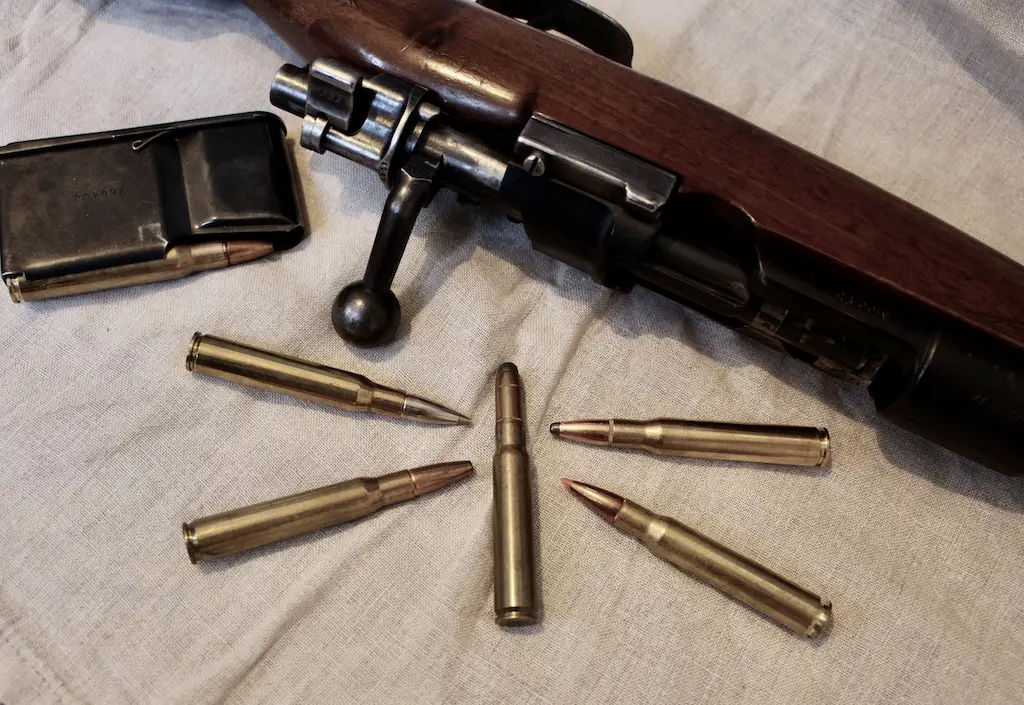
30-06 vs 8mm Mauser: Which Is Right For You?
Both the 8x57IS and the .30-06 are great all around hunting cartridges that excel within the first 400 yards of distance. They’re both used for a variety of purposes in Europe: hunting for red, fallow and roe deer, wild boar and even bear and moose in woods and open terrain alike.
You will probably find fewer people carrying the 8mm cartridge up a mountain for chamois than the .30-06, but shot distances on average are much shorter in Europe than in North America. With lighter bullets, the 8x57mm will still get the job done on most hunts in the Alpes.
Both are equally useful on driven hunts in Europe as well as for deer hunting over food plots in North America.
Since shots rarely exceed 300 yards in Africa as well, both are more than adequate on antelope up to eland. Loaded with good bullets, even those heavyweights hit the ground quickly and cleanly.
South America and Asia can be hunted successfully with either one. Most ungulates won’t be disappointed when you use them, but none of them would be my choice on a mountain game hunt in Asia.
The same goes for the high altitude places of New Zealand. You don’t have to shoot 400 yards everywhere in NZ, but some places and species require longer pokes on a regular basis. The thick forests you can find in many places are a nice playground for the .30-06 and the 8x57mm alike.
The North American continent offers a divers range of hunting opportunities. The slightly flatter trajectory of many .30-06 loads will make it a good choice for use on animals at longer range. Think of western hunts in open terrain where the 30-06 is a little more versatile.
Neither would be my first choice for use on dangerous game like brown bears, polar bears, or cape buffalo.
That said, Roy Lindsley used a 30-06 to take what is still the biggest Alaska brown bear in the record books back in the 1950s. So, it will clearly get the job done under the right circumstances, especially with a good quality 180, 200, or 220 gr bullet!
Both cartridges are capable of excellent accuracy, but they’ve both been overtaken by other rounds in target shooting. For aficionados of military cartridges there are only few other cartridges that carry more history than these two though.
It’s clear that both will work well in a whole lot of hunting scenarios, but they’re not totally interchangeable.
The 8mm Mauser works great for general hunting on medium-sized game and even bigger game where you keep your shots inside 300 to 350 yards. But keep in mind that the invention of precise range finders diminishes the need for super flat trajectories.
The slightly larger bullet width will give you a slim advantage in frontal surface, which translates to a bigger hole. Also, many hunters feel like wider bullets add a bit of oomph or knock down power. The shorter barrels you can use with this round without sacrificing a lot of speed make this a perfect round for the use of silencers.
Getting off more shots, for example on crop raiding hogs, might prove easier then. A definite downside is the much more circumscribed distribution of 8mm Mauser rifles and the much smaller ammunition availability, especially outside of Europe and certain places in Africa.
If being different is your way, this is the cartridge for you.
The .30-06 is so widely available around the globe that you may never run out of ammunition as long as you can find an ammo store. With a vast selection of factory loaded ammo and components alike, there’s little walking this planet that you can’t hunt with a .30-06, especially with something like a 180 grain load.
It can a bit flatter with more aerodynamic projectiles, which makes it easier to hit targets further down range. Still, this is no true Long Range round either, and the cartridge has an effective range of 400, maybe 450 yards under most conditions.
A rifle will be a bit less handy in tight quarters, without being a huge disadvantage. Using a silencer in such landscape is slightly more uncomfortable, but doable. Narrower bullets of a given weight have a higher sectional density and a higher BC, which translates to better penetration and external ballistics. The difference is not huge, but you should consider that.
In the end, it’s hard to crown a winner in the 8mm Mauser vs 30-06 debate.
Me personally?
I would keep my own .30-06 bolt rifle and get rid of my 8x57IS if I had to chose one for the rest of my hunting career.
It would be a tough decision for sure though.
NEXT: BEST 6.5 CREEDMOOR AMMO FOR HUNTING ELK, DEER, & OTHER BIG GAME
NEXT: BEST GIFTS FOR HUNTERS
Enjoy this article comparing the 8mm Mauser vs 30-06 Springfield cartridges? Please share it with your friends on Facebook and Twitter.
Make sure you subscribe to The Big Game Hunting Podcast and follow The Big Game Hunting Blog on Facebook, Instagram, Twitter, and YouTube.
John McAdams is a proficient blogger, experienced shooter, and long time hunter who has pursued big game in 8 different countries on 3 separate continents. John graduated from the United States Military Academy at West Point and is a veteran of combat tours with the US Army in Iraq & Afghanistan. In addition to founding and writing for The Big Game Hunting Blog, John has written for outdoor publications like Bear Hunting Magazine, The Texas State Rifle Association newsletter, Texas Wildlife Magazine, & Wide Open Spaces. Learn more about John here, read some of John’s most popular articles, and be sure to subscribe to his show: the Big Game Hunting Podcast.

